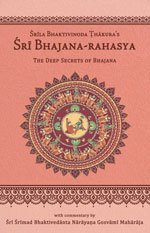Bhajana-Rahasya
by Srila Bhaktivinoda Thakura Mahasaya | 2010 | 123,965 words
The Bhajana-rahasya Text 18, English translation, including commentary (vritti). The Bhajana-rahasya is a compilation of verses describing the mercy of the eight pairs of names (Yugala-nama) of the Maha-mantra. This is text 18 belonging to the chapter “Shashtha-yama-sadhana (Sayam-kaliya-bhajana–bhava)” representing six dandas after dusk: approximately 6.00 p.m.–8.30 p.m.
Text 18
Śrī Kṛṣṇa’s beauty attracts the hearts of all. Śrīmad-Bhāgavatam (9.24.65) describes the Vrajavāsīs’ anger towards Lord Brahmā for making eyes that blink and thus obstruct their vision of Kṛṣṇa while they drink the beauty of His form:
यस्याननं मकर-कुण्डल-चारु-कर्णभ्राजत्-कपोल-सुभगं सविलास-हासम्
नित्योत्सवं न ततृपुर् दृशिभिः पिबन्त्यो नार्यो नराश् च मुदिताः कुपिता निमेश् चyasyānanaṃ makara-kuṇḍala-cāru-karṇabhrājat-kapola-subhagaṃ savilāsa-hāsam
nityotsavaṃ na tatṛpur dṛśibhiḥ pibantyo nāryo narāś ca muditāḥ kupitā nimeś caThe makaras haped earrings that swing on Śrī Kṛṣṇa’s ears play in the lake of His cheeks, and this splendour increases even further the beauty of His cheeks. When He smiles with enjoyment, the bliss that is always visible on His face is augmented. With the cups of their eyes, all the residents of Vraja, men and women alike, drink the nectarean beauty of His lotus face. They are never satiated, however, so they become angry with Brahmā for creating eyes that blink and thus obstruct their relish of this sweetness.
सुभग-कपोल हेरि’ मकर-कुण्डल
सविलास हास्य-मुख-चन्द्र निरमलsubhaga-kapola heri’ makara-kuṇḍala
savilāsa hāsya-mukha-candra niramalaनर-नारी-गण नित्य-उत्सवे मातिल
निमेष-कारीर प्रति कुपित हैलnara-nārī-gaṇa nitya-utsave mātila
nimeṣa-kārīra prati kupita haila
Commentary: Bhajana-rahasya-vṛtti:
Śrīla Śukadeva Gosvāmī, radiant with joy, began to describe the sweetness of Śrī Kṛṣṇa’s beautiful form to Mahārāja Parīkṣit. When the Vrajavāsīs see this beauty, they are overwhelmed with prema and their own loving attachment (anurāga) is unlimitedly amplified, attaining a delightfulness beyond description. The vraja-sundarīs, filled with mahābhāva, relish Kṛṣṇa’s extraordinary beauty to its fullest extent due to their very thick and deep anurāga. Their sentiments are on the topmost level, and although there is no higher position, their transcendental moods keep increasing to the stage of yāvad-āśraya-vṛtti{GL_NOTE::}. In this state of anurāga, which cannot be described in words, they experience nothing but rasa. They attain sva-saṃvedya-daśā{GL_NOTE::}, which is the ultimate stage of mahābhāva. This condition is the wealth of the vraja-sundarīs alone.
The radiance of Śrī Kṛṣṇa’s divine earrings glows on His cheeks, which are encircled by locks of curly hair. An eternal festival of unprecedented beauty suffuses His charming lotus face. In the centre of this eternal festival, a gentle, nectarean smile gracefully resides, like the emperor of the sweetest of all sweetness. Śrī Kṛṣṇa is at the juncture of childhood (paugaṇḍa) and adolescence (kiśora);and thus happiness, impatience, liveliness and so forth have appeared on His lotus face, revealing His restlessness. His white teeth, stained by chewing tāmbūla, and His reddish lips, endowed with a charming smile, have reached the extreme limit of beauty.
It seems that on the full moon night, the moon rays remove the burning suffering of all living entities and give rise to greed in the hearts of the devotee-like cakora birds. In the same way, when the vraja-devīs see the unprecedented sweetness of Śrī Kṛṣṇa’s beauty, their ocean of kāma (lust) increases. Kṛṣṇa’s beauty thus destroys their consideration of family, caste, religion, constancy and so forth.
They become besotted and drown in an ocean of bliss. Constantly swinging makaras haped earrings dance on the cheeks of Śrī Kṛṣṇa’s gentle, softly smiling face as they embrace and kiss His cheeks. When the gopīs see this, Śrī Kṛṣṇa appears in their hearts as dhīra-lalita, a hero expert in amorous sports. The earrings’ touching and embracing His cheeks is suggestive of His intention to embrace the vraja-sundarīs and kiss their breasts.
The gopīs, however, are not thoroughly satisfied by watching the festival of Śrī Kṛṣṇa’s sweetness in this way. Angry with Brahmā for creating eyelids that momentarily interrupt their darśana, they curse him. “Brahmā is not qualified to create. To view such a beautiful scene, he has given only two eyes, and they even have doors on them in the form of eyelids! After dying, we will become Brahmā in our next lives and show how creation should be done. Two eyes alone are not sufficient to behold such elegance and beauty. The entire body should have eyes with no eyelids, so that we can have unlimited darśana of Kṛṣṇa without blinking!”
The words nāryo narāś ca in this Text indicate that all the Vrajavāsīs, men and women alike, drink the nectarean beauty of Kṛṣṇa’s lotus face. Nāryaḥ means Rādhā and the other gopīs, and narāḥ refers to Subala and other priya-narma-sakhās.
Only in Vraja are Śrī Kṛṣṇa’s four unique qualities–premamādhurya, līlā-mādhurya, rūpa-mādhurya and veṇu-mādhurya–present in their most complete form. For this reason, there is a special importance and a distinguishing virtue that Vraja-dhāma has over other dhāmas and that Vrajendra-nandana Śrī Rādhā-ramaṇa and the vraja-gopikās have over other incarnations.
